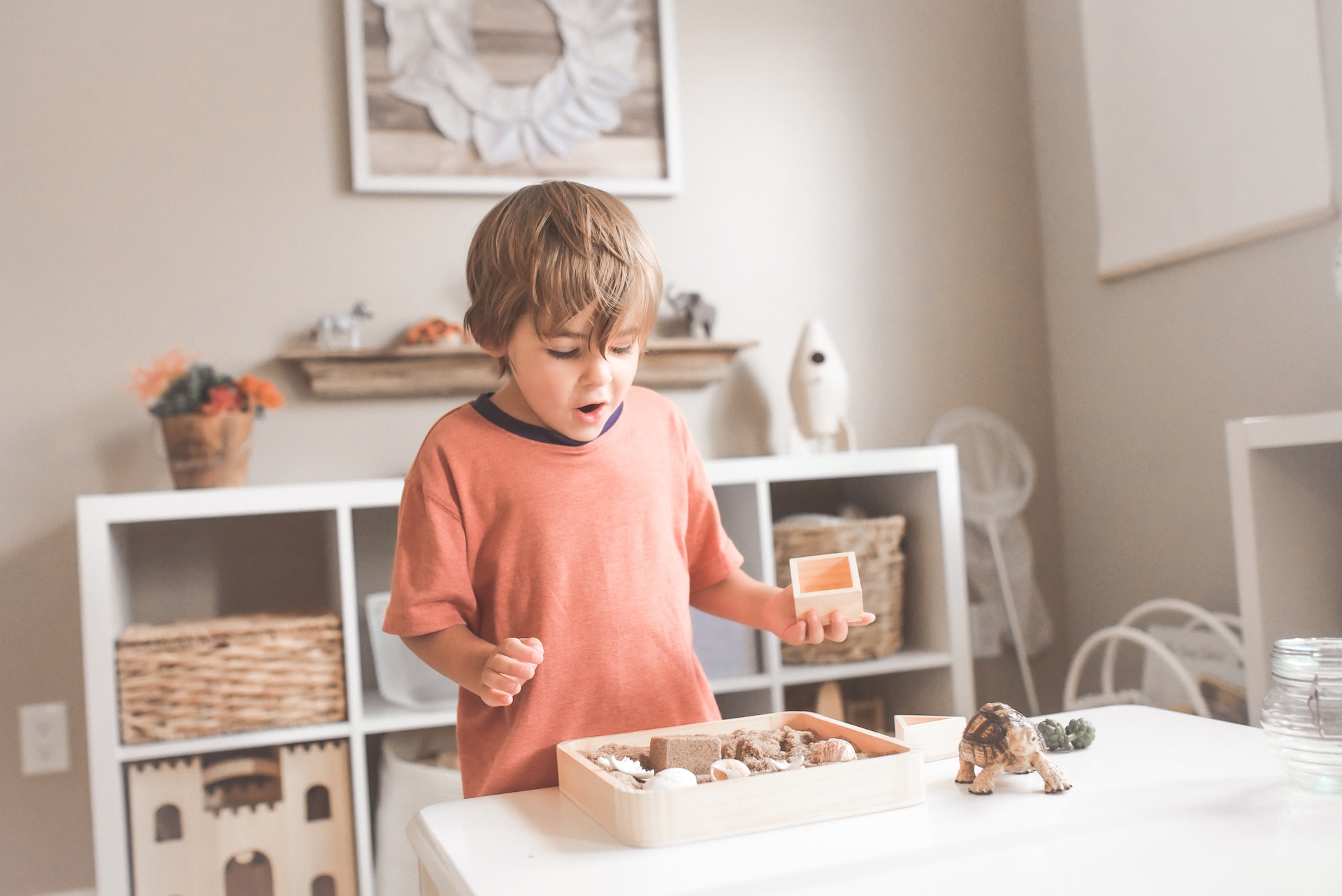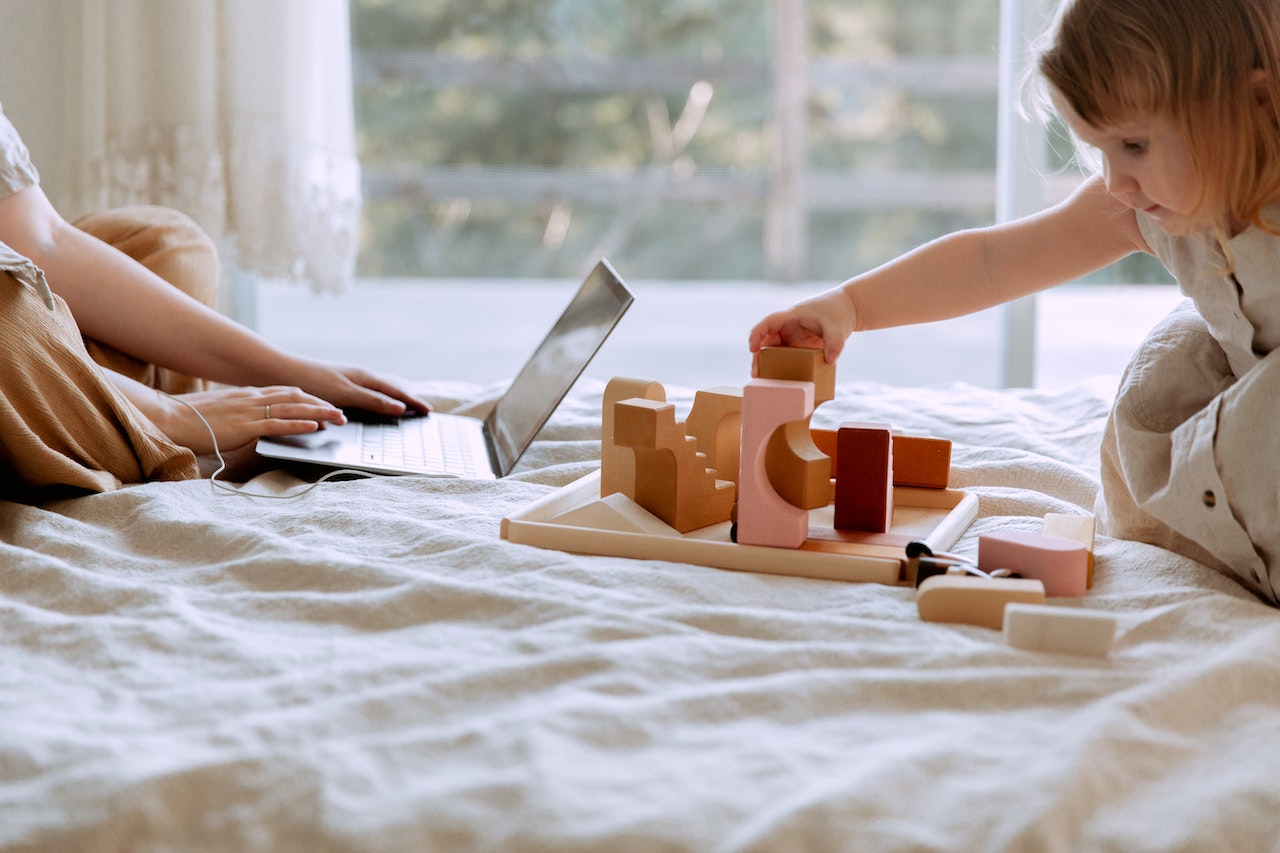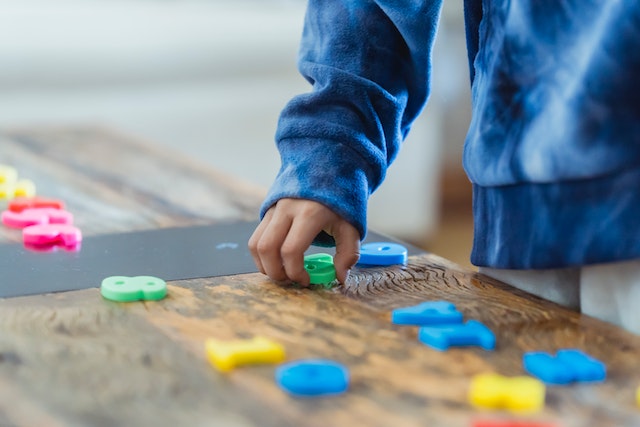Here are ideas for keeping kids busy while you need to get things done around the house. None of them will make a mess, and most can be done with items you have around the house already.
-
- Magnets: make magnets for kids so that they can play with them while you are cooking
- Picture magnet
- You will need: 8 x 10 picture, 8 x 10 piece of cardboard, glue, magnet strip
- Glue the picture to the cardboard
- Cut the picture into pieces (make large, regular shapes for younger children, and small, irregular shapes for older children)
- Glue a small piece of the magnetic strip on each piece picture piece
- Show your kids how the picture fits together, then separate the pictures and let them try to put it together like a puzzle
- Letter or word magnets
- Buy magnet sets where each magnet is a letter (for younger children) or each magnet is a word (for older children)
- Have children put together the letters to make words, or put together the words to make sentences
- Cookie sheet magnets
- Glue green wrapping paper or tissue paper (cut to fit) onto a cookie sheet that you do not plan to use again. Purchase small figurines, houses, buildings, and cars from a used toy store. Glue magnets to the bottoms of these toys, and let the children create a little town.
- Use your imagination to create variations of the above description: you can use clothes on the outline of a person or facial features on the outline of a face.
- Beads: Buy a lot of inexpensive beads in a variety of colors – make sure that they’re big enough to find if scattered across the floor!
- Separate by color: Give the child a lot of little dishes and have them separate the beads by color, so that the yellows are all in one dish, the blues are all in one dish, and so on
- Make a pattern: Give the child a string or shoelace and ask them to make a pattern with the beads, for instance, red, purple, red, purple, and so on. If they are too young to understand patterns, they will enjoy just stringing the beads.
- Get double prints of pictures of people your child knows such as close friends or grandparents. Cut out the picture so that you just see the person’s face (to about wallet size), and laminate so they make little cards. Mix all of them up, and have your kids try to find matches.
- Fill a large sandwich bag with play-doh, kids’ play gel, or sand. Hide very small toys in the bag and cover them up. Seal the bag very tight, and have the kids look for items and tell you what the find. For younger kids, it will be fun for them to just play with the bag and squish it in their hands. You can also make “goop” by either using uncooked biscuit dough, or through the following: mix 2 cups salt, 1 cup water, 1 cup cornstarch; cook salt and ½ cup water for 5 minutes on medium heat, remove from heat and add cornstarch and remaining water, return to heat and stir until mixture thickens.
- Sensory Activities
- Make a book of different textures. You can use fabric scraps or any flat (or almost flat) household object.
- Let them play with packing material. Kids love to pop bubble wrap. You can also give them a sheet or small box of Styrofoam and objects that are sharp enough to stick in the Styrofoam, but not sharp enough to hurt them (such as golf tees or bobby pins).
- Adventures
- Gather up some of the child’s smaller toys. After making a list of them, hide them in nearby places. Using the list, tell your child the name of one toy at a time and have them go find it. Once they find it, tell them the name of the next toy on the list.
- Scavenger Hunt: Write down a list of items that the child will be able to find in the area you are working. See how quickly the children can find the items.
- Create a masking tape obstacle course. This works best on carpet, but will work on wood floors too. You can create a target for them to throw a ball in (show them how to try and hit the bull’s eye). You can also create a masking tape hopscotch, or create parallel lines and see how far they can jump (trying to jump to the farthest line). Make one long straight line to have them pretend like they are walking on the balance beam, and then many little circles so they can jump from one to the other.
- Some of the ideas earlier in this list may be adapted for younger children, so look through those first.
- I’ve found that younger children are most easily entertained with household objects, rather than toys. My children always enjoyed cooking utensils, inexpensive jewelry, and magazines.
- You can make simple, inexpensive toys that children love. You can fill an empty can or canister with beans or rocks and put the lid on for a noisemaker. Or, you can cut strips of paper and make them into rings, intertwined with each other to make a chain. Children will be able to pull them apart, but it will provide just enough of a challenge to keep them busy for a while.
- Younger Children
- Food usually keeps children entertained longer than toys. Sometimes, sitting your young child in his or her highchair with finger food will give you enough time to finish a few chores.
- Young children love to see themselves; you can set up a large mirror for them to look in for fun.
- Fill up a plastic water bottle with water, a little food coloring, and a few small toys. Tape the lid on tight! Children like to watch the toys floating around in the water.
- Fill up a bucket with a variety of objects including large rocks, tissue paper, and household objects. Let them dig through the bucket and explore the items.
- Build up a tower with Legos, Lincoln Logs, or paper towel rolls and let them destroy it. Young children aren’t yet able to build structures, but they love to destruct them.
- Ready-Made Bags: Keep a small bag of toys in a common area of the house; I like to keep one for each of the following activities, and this is the only time the kids can use this bag
- Telephone bag (for when I’m on an important call): Play-Doh and plastic cookie cutters
- Baby-Sitter bag (for when the babysitter comes over): 2 books, 1 movie, 1 travel-size board game
- Laundry bag (for when I’m folding laundry): a small bag of doll-size or infant-size clothes so that they can fold clothes with me; a small basketball with a hoop that I can set up right next to the laundry station
- I’m Bored Jar: This is a mason jar that I keep with all of the activity ideas described above; when the kids are bored I let them pull out an idea.
Make Reading a Priority
Numerous studies have demonstrated the value of reading on children’s growth. Reading fosters cognitive development—the capacity to reason and comprehend—according to the Encyclopedia of Children’s Health. Reading to your child can aid in the development of their cognitive abilities, including memory, problem-solving, and decision-making.
Consider establishing a scheduled reading period. A child can benefit from just 15 to 20 minutes of reading each day, and you can even divide that time into smaller blocks. Consider reading aloud to your kids or having them do it for you. Encourage your kid to read even more if they wish to. A schedule is established for each day since your child knows they will have reading time every day, which is an extra benefit. You may download and rent books for nothing via local libraries’ applications.
Online Learning
Numerous academic institutions and research institutions have produced cost-free instructional materials for both children and adults throughout the quarantine.
For students in grades K–2, 3-5, and 6–12, National Geographic has created a Learn at Home program. For interesting, enjoyable, and skill-building classes in social studies, geography, science, and other subjects, the lesson plans can be completed at home with a minimum of materials.
Virtual tours of artwork, mansions, historical structures, well-known American landmarks, and more are available at many museums. The Exploratorium, Book Shark, National Science Digital Library, History Channel, and USHistory.org all provide virtual tours and entertaining education that kids can enjoy at any time.
The Metropolitan Library System still offers a variety of services and programs that families can take advantage of even while its physical buildings are closed. Want to pick up a new trade or language? Try Lynda.com or Mango Languages. Need to do some exam preparation or investigate a subject for class? Visit LearningExpress, Explora, and Help Now.
The library is also experimenting with a number of online classes delivered via Facebook Live and Zoom. You can sign up for these sessions on their events calendar, and you’ll get an email with a Zoom link so you can join the audience or watch it on Facebook Live. Classes consist of:
- Genealogy 1-on-1 Appointments
- Online Community Coffees
- Job Resources
- Online Learning
- Storytimes
- Book Club Discussions
Healthy eating at home
It’s important to maintain a nutritious diet during these trying times, and involving kids in meal preparation and planning is a fun approach to teaching them about nutrition.
Cooking With Kids, a great PBS website with kid-friendly programs, encourages kids to experiment with other cultures and cuisines in the kitchen.
Try some gardening with your kids when the weather is warmer. Let children choose the seeds they want to use, and then you can all watch the garden develop together. Harvesting fruit or vegetables can be a family activity that teaches kids about the origins of their food.
Try conducting a kitchen-themed scavenger hunt. Make a note of the goods you have in your pantry and refrigerator and categorize them into groups such as fruits, grains, vegetables, dairy, and protein. As they look for each item on the list, let your kids explore the various food varieties.
Limit high-calorie or highly processed foods like chips or candy and opt instead for healthy snacks like almonds or fruit. Additionally, too much sugar can make kids hyper, which is a disaster waiting to happen if they are already bored.
Get artistic
There are numerous apps available right now that can assist kids in learning new languages. Students can learn new vocabulary through engaging, quick-paced games with straightforward mnemonic imagery using apps, and you can select from more than 35 different languages.
You can find art classes and activities that will challenge your child’s mind while they are having fun in the enormous world of online learning and art.
Importance Of Keeping Your Kids Busy And Active During Summer With Summer Camps
As summer approaches, parents must make plans for how they will spend time with their kids while we are away at work each day. The summertime seems to be a time when parents have too much to do and kids don’t have enough to do. Keeping our kids occupied and active over the summer is crucial for their mental health as well as for their general physical well-being. Children should be encouraged to participate in physical activity from a young age in order to help them form the habits and abilities necessary to continue being active throughout their life.
Being physically active is crucial for our kids for a variety of reasons. Children who engage in physical activity have stronger bones and muscles, healthy growth and development, improved skills and balance, the ability to maintain and reach a healthy weight, and higher self-esteem. Jumping jacks, a trip to the park to climb on the jungle gym, a walk, a swim, or a game of tag are just a few of the enjoyable activities parents can do with their kids to keep them moving. Additionally, you may make a fun “Family Fitness Night” out of exercising. Kids love it when they do this at home because not only are we all working out together as a family, but it also makes exercise enjoyable.
Children at some clubs have daily opportunities to engage in physical activity in a fun and secure setting. We give children this chance by sponsoring summer camps. Beginning in June and lasting through August are our summer camps. Our camps aim to help kids develop personally, enhance their interpersonal and social skills, embrace diversity, learn specialized skills, be physically active all summer long, and most importantly, have fun. Camps are made to enhance a child’s self-esteem as well. To cater to people of different ages, genders, and personalities, also provide a wide range of camps. Our camps give parents the assurance that their children are taking part in safe activities that will improve their general well being.
Children’s physical activity is crucial. Children feel pleased when they move. Parents are delighted when their kids are happy because we always have their best interests in mind.
Benefits of Having a Busy Kid
Being very entertained in children isn’t always a bad thing. Consider these advantages of raising active or “busy” children.
1. Having busy kids promotes positive relationships
When children are engaged in their favorite activities, they are likely to run into other children who share their interests. Any child’s life has to have healthy relationships. Their kids get along well with those who participate in the activities they do. They get along well with both the kids and the adults.
2. Being busy can help kids gain confidence
Kids who participate in activities they enjoy can develop a lot of confidence. The child might not have much confidence when they first start, but as they improve, their confidence will keep increasing. They’ll be eager to share with you what they’ve learned from the activities they’re participating in in no time.
3. Being busy can help kids learn teamwork
The majority of parents are aware that when children are at home with their siblings, they only seem to quarrel. On the other hand, children learn teamwork while they are outside being active and doing things they enjoy. They won’t have the chance to argue back and forth while engaging in their hobbies. They won’t have time since they’ll be too busy learning how crucial teamwork is.
Bear in mind that not only sports teams need to function as a team; scouts also need to construct things and establish camps.
4. Being busy builds character
What you do when no one is looking shows your character. This is especially true for children who are engaged in activities. Even if you can’t monitor them the entire time, they are developing a lot of personality. They pick up knowledge from both their professors and the people they spend time with.
Being busy isn’t always a terrible thing because our children are developing virtues that will serve them well in the future.
5. Having a busy kid help your kid never stop learning
We don’t know about you, yet we adore seeing youngsters engaged in activities they love. It indicates that they are learning. For instance, your eldest wants to know what happens every day since he experiences some worry. He requires that structure and regularity. You must thus motivate him to engage in the activities he enjoys.
Find a science group or local library for activities if your child enjoys science. Is your child a horse fan? There is a ton lot learn if you try horseback riding. Whatever your child enjoys, you may find an activity that will suit their interests and demonstrate to them that learning is enjoyable. I’ve discovered that keeping your children engaged in learning is beneficial. They experience constant growth while having a great time.
Conclusion
It’s important to keep kids occupied for their cognitive, emotional, and physical growth. Children learn new abilities via participating in a variety of activities, such as games, athletics, arts and crafts, and reading, but they also form relationships with others and develop their creativity. Children should be encouraged to participate in activities that interest them and given chances to explore their interests.



